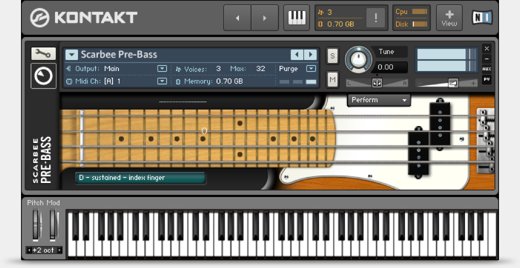Fodera Yinyang
Let's imagine this situation: we will give two different people headphones with an ideally accurate frequency response and ask for opinion. The first is usual average people, which does't see any reason to pay for headphones more than 2 bucks. The second is a person who has good hearing and extensive knowledge about sound (musician, sound engineer, etc.). I think you can imagine what they will say.
Approximately the same thing here. It would seem, four strings, standard tuning, two pickups, well, what can you think of yet? However, from very beginning, you understand that this is something unusual. Then we googled the title of this instrument and see that the same device uses Victor Wooten. A specialist of this level can't take bullshit.
Advantages:
- Suitable for soloing and non-standard ideas. Perfect sounding of hammer-on/pull-off, natural harmonics, slap, tapping and scales. Very soft glissando.
- There are many different instruments for forming a timbre. There is a distortion here - you can feel like Cliff Burton.
- You can choose between active and passive electronics.
- Sound is completely processed - there are no unnecessary resonances, noises.
- Significantly shortens running time without losing sound quality - many elements are automated. Just write or import midi file into track, select elements of timbre and enjoy result.
- Also here is the function Riffer, which makes it easy to compose parts or generate random.
- Interface is well thought out - very convenient arrangement of elements.
Disadvantages:
- Apply this instrument to a usual rhythm section - it's like digging a garden in a tuxedo. Yes, this plugin has a very interesting sound, but to pull the fourth string under the bass drum is better to choose something else.
- It requires a lot of CPU resources.
- Automation erases some shades. For example, here is a strange (for real instrument) algorithm for switching strings, but it can't be done manually.
Scarbee pre-bass
Sound of legendary Fender Precision Bass '72 is now available in VST format. Further description is pointless: this instrument has been showing excellent sound for decades. Users are given a clean sound. Absolutely clean - sound was recorded in a line.
Advantages:
- A raw sound that can be finely tuned in accordance with your artistic task.
- Extensive possibilities: suitable for soloing and rhythm section. Everything depends only on your artistic task, your knowledge, your imagination and the resources of your cpu.
- Strings can be switched manually. This is very important: one note can be played in different ways, but usually only one sound is recorded.
- Composer not only hears, but also sees the process. Below the neck there is a text footnote that displays the last note and the last used articulation.
- Minimum interface elements is only what is needed.
Disadvantages:
- Bad suitable for non-standard ideas.
- The need for fine-tuning sound is a lot of time spent. Add an cabinet emulator, remove resonances and noise. Not everyone likes this. And also the whole process of processing can take much more CPU resources than previous plug-in.
- Do you think that simplicity is a small amount of CPU resources? This is not always true. This plugin is just part of one large Kontakt platform, which is very demanding on CPU.
Here are such interesting opposites.


